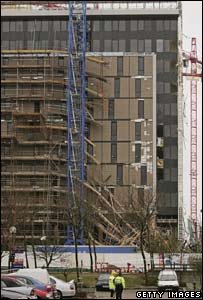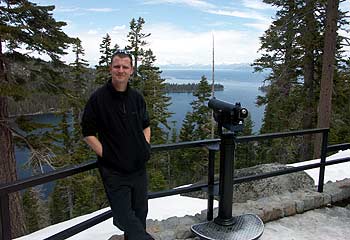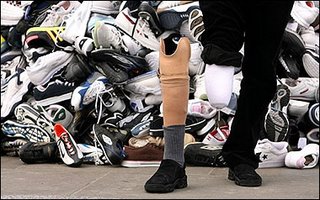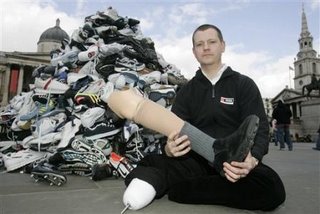Wifi is now available in many Californian State Parks, which means I can check my email from my laptop while sitting on a log overlooking Morro Bay.
Thursday, April 27, 2006
The number of places where you can hope to be undisturbed by modern technology continues to shrink.
Wifi is now available in many Californian State Parks, which means I can check my email from my laptop while sitting on a log overlooking Morro Bay.
Wifi is now available in many Californian State Parks, which means I can check my email from my laptop while sitting on a log overlooking Morro Bay.
Saturday, April 22, 2006

Thanks to everyone who's e-mailed in the last few days saying "where the hell are you" or words to that effect.
I didn't mention it pre-departure but Aileen and I are enjoying a little Spring break. We've rented an RV and are on a two-week Californian road trip.
We're currently amid the splendour of lake Tahoe.
Next stop Yosemite.
Wednesday, April 12, 2006
 You probably didn't notice, but a minor revolution took place in British journalism yesterday.
You probably didn't notice, but a minor revolution took place in British journalism yesterday.The story at the centre of the storm was mediocre to say the least -- the collapse of 14 stories of scaffolding in Milton Keynes.
What was revolutionary was the way the audience responded to the event.
Within minutes of the collapse, the BBC had received some 600 photos e-mailed by eye-witnesses. Some were put on air immediately, long before the "real" reporters and satellite trucks arrived.
Other people e-mailed eyewitness accounts, together with contact details which were followed up when reporters arrived on the scene.
The user-generated content flooding in drove the newsgathering operation, with the work of citizen and "professional" journalists seamlessly complementing one another.
It was a glimpse of the future.
Sunday, April 09, 2006
Friday, April 07, 2006
One to file in the "stories I must look at in the future" folder -- the Wounded Warrior Project, a non-profit organisation set up to help severely injured servicemen, including many amputees, rebuild their lives.
Thursday, April 06, 2006
ABC explores the strange world of pretenders and wannabes.
Wednesday, April 05, 2006
Tuesday, April 04, 2006
Now running on the Press Association newswire....
GIANT PILE OF SHOES MARKS MINE TOLL
By Alison Purdy, PA
A huge pile of shoes was built in Trafalgar Square today to highlight the plight of millions of people affected by landmines throughout the world.
The Mass Of Shoes was created as part of Landmine Awareness Day, the first UN international day for mine awareness and assistance in mine action.
Celebrity supporters of the Mines Advisory Group, MAG, a non-governmental organisation that works for the clearance of mines, attended the central London
display.
Actress Vanessa Redgrave, former journalist and independent MP Martin Bell and Seventies singer-songwriter Julie Felix were among those who stepped out today in support of the charity.
Each of the 2,000 shoes that made up the pile of footwear represented a life lost to landmines so far this year.
An estimated 15,000-20,000 people - one every 20 minutes - are killed or
injured each year by mines and other munitions.
Some of the worst-affected areas are former war-torn countries of Africa, including Angola, Sudan, Chad and the Democratic Republic of Congo, and Cambodia.
MAG works in 14 countries to clear mines and educate people about them and has helped halve victim rates in many places.
Mr Bell, who during his time as a journalist covered conflicts across the world, said the main problem faced by the organisation was financial as it costs an estimated #2 to lay a mine and #200 to clear it.
"Landmines have the effect of completely destroying civilian lives as no-one can move about," he said.
"Agriculture ceases because landmines tend to be sown in arable areas.
"The problem is they are so cheap to lay and so expensive to move, and in my experience the militia who plant them leave no maps," he said.
Mr Bell said the most vulnerable groups were farmers and children.
"It means whole communities cannot move about.
"What MAG does is go out to these countries and train local people to lift the mines, but it all costs money.
"I would like to think that, with the work of organisations like MAG, more landmines are now being cleared than are being sown."
In a poignant display of the damage landmines can cause, BBC journalist Stuart Hughes, who lost a leg after stepping on a landmine while covering the war in Iraq, detached his artificial limb and posed for photographers in front of the mound of shoes.
He said: "I think a lot of people think the landmine problem has gone away, but seeing this physical symbol of the lives lost this year brings it home.
"Most landmine survivors are not as lucky as me and do not have access to the medical care I received."
MAG executive director Lou McGrath said: "In one year alone we cleared well over a million dangerous items in Iraq due to the sort of government support the UN is calling for.
"However we know that clearing landmines plus the bombs, abandoned small arms or large missiles, and even providing education, training and employment as we do in our programmes is not enough, especially for the poorest communities we work in.
"Mine action has to be part of a country's wider development needs and it has to benefit the way communities live, work and develop in order that they can truly recover from conflict.
"Government and public support isn't limitless so we're grateful the UN has launched such an important day to remind the world we need to destroy these weapons that devastate so many innocent lives."
GIANT PILE OF SHOES MARKS MINE TOLL
By Alison Purdy, PA
A huge pile of shoes was built in Trafalgar Square today to highlight the plight of millions of people affected by landmines throughout the world.
The Mass Of Shoes was created as part of Landmine Awareness Day, the first UN international day for mine awareness and assistance in mine action.
Celebrity supporters of the Mines Advisory Group, MAG, a non-governmental organisation that works for the clearance of mines, attended the central London
display.
Actress Vanessa Redgrave, former journalist and independent MP Martin Bell and Seventies singer-songwriter Julie Felix were among those who stepped out today in support of the charity.
Each of the 2,000 shoes that made up the pile of footwear represented a life lost to landmines so far this year.
An estimated 15,000-20,000 people - one every 20 minutes - are killed or
injured each year by mines and other munitions.
Some of the worst-affected areas are former war-torn countries of Africa, including Angola, Sudan, Chad and the Democratic Republic of Congo, and Cambodia.
MAG works in 14 countries to clear mines and educate people about them and has helped halve victim rates in many places.
Mr Bell, who during his time as a journalist covered conflicts across the world, said the main problem faced by the organisation was financial as it costs an estimated #2 to lay a mine and #200 to clear it.
"Landmines have the effect of completely destroying civilian lives as no-one can move about," he said.
"Agriculture ceases because landmines tend to be sown in arable areas.
"The problem is they are so cheap to lay and so expensive to move, and in my experience the militia who plant them leave no maps," he said.
Mr Bell said the most vulnerable groups were farmers and children.
"It means whole communities cannot move about.
"What MAG does is go out to these countries and train local people to lift the mines, but it all costs money.
"I would like to think that, with the work of organisations like MAG, more landmines are now being cleared than are being sown."
In a poignant display of the damage landmines can cause, BBC journalist Stuart Hughes, who lost a leg after stepping on a landmine while covering the war in Iraq, detached his artificial limb and posed for photographers in front of the mound of shoes.
He said: "I think a lot of people think the landmine problem has gone away, but seeing this physical symbol of the lives lost this year brings it home.
"Most landmine survivors are not as lucky as me and do not have access to the medical care I received."
MAG executive director Lou McGrath said: "In one year alone we cleared well over a million dangerous items in Iraq due to the sort of government support the UN is calling for.
"However we know that clearing landmines plus the bombs, abandoned small arms or large missiles, and even providing education, training and employment as we do in our programmes is not enough, especially for the poorest communities we work in.
"Mine action has to be part of a country's wider development needs and it has to benefit the way communities live, work and develop in order that they can truly recover from conflict.
"Government and public support isn't limitless so we're grateful the UN has launched such an important day to remind the world we need to destroy these weapons that devastate so many innocent lives."
Monday, April 03, 2006
Tomorrow marks the catchily-titled First International Day for Mine Awareness and Assistance in Mine Action.
I'll be doing my bit with MAG in Trafalgar Square.
I'll be doing my bit with MAG in Trafalgar Square.
Five minutes ago, it dawned on me that I'd forgotten a special person's birthday.
I'm genuinely shocked I didn't remember, because the birthday boy in question is very dear to me.
Three years ago yesterday, Mr Stumpy blasted into life in Northern Iraq.
I can't believe it's been three years -- but I also can't believe the significance of the date didn't register yesterday.
But perhaps taking part in the Kingston Breakfast Run was exactly the way I should have been marking the anniversary.
I'm genuinely shocked I didn't remember, because the birthday boy in question is very dear to me.
Three years ago yesterday, Mr Stumpy blasted into life in Northern Iraq.
I can't believe it's been three years -- but I also can't believe the significance of the date didn't register yesterday.
But perhaps taking part in the Kingston Breakfast Run was exactly the way I should have been marking the anniversary.
Sunday, April 02, 2006
One of my selfish pleasures when racing is to cruise past people who appear to be struggling, so they can tell their running buddies they were overtaken by a bloke with one leg.
Looking at the comments about the Kingston Breakfast Run on the Runners World message board, it seems my tactic has been noted:
"Got overtaken by a bloke with one leg, fantastic, and good luck to him, i was just terrified that his false 'bouncy foot thing' would slip on the mud!"
Don't worry, mate, I know exactly what I'm doing. Eat my dirt!
Looking at the comments about the Kingston Breakfast Run on the Runners World message board, it seems my tactic has been noted:
"Got overtaken by a bloke with one leg, fantastic, and good luck to him, i was just terrified that his false 'bouncy foot thing' would slip on the mud!"
Don't worry, mate, I know exactly what I'm doing. Eat my dirt!
Never mind the Boat Race, the top sporting event in south west London today was the Kingston Breakfast Run.
I was up at sparrows to get ready for the 0800 start for the 8.2 mile course -- my longest race so far.
The step up from 10k didn't seem to make much difference in the legs, although I deliberately took it easy to make sure I didn't blow out too early.
The slow mass start affected my time and it was 10 minutes before I really got into my stride.
My time was a mediocre 1hr 21m but, more importantly, I now feel much more confident about next weekend's Towpath 10 and, beyond that, the Brussels 20k.
I was up at sparrows to get ready for the 0800 start for the 8.2 mile course -- my longest race so far.
The step up from 10k didn't seem to make much difference in the legs, although I deliberately took it easy to make sure I didn't blow out too early.
The slow mass start affected my time and it was 10 minutes before I really got into my stride.
My time was a mediocre 1hr 21m but, more importantly, I now feel much more confident about next weekend's Towpath 10 and, beyond that, the Brussels 20k.



